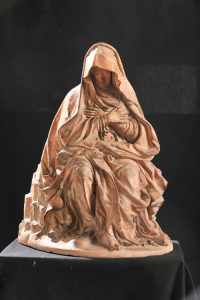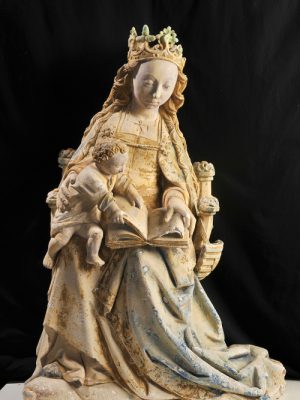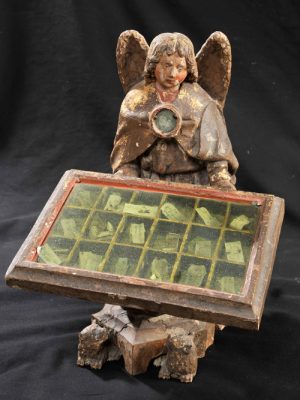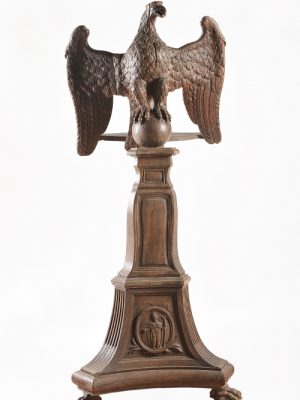Mater dolorosa
Workshop of Germain PILON (attributed to)
France
Second half of the 16th century
Terracotta
Deposit from the church of Bray, Rully, 1983
Classified as a Historic Monument
Inv.D1983.2.2
_________________________
The Virgin is shown sitting on a rock and mourning the death of her son, Jesus Christ. The abundance and overflowing aspect of the drapery highlight the dramatic image of this grieving mother, while testifying to the great virtuosity of the sculptor in his modelling work.
This artwork is one of the last traces of large artistic commissions from the French Renaissance. To pay homage to King Henri II, his widow, Catherine de Medici, had a circular funerary chapel erected by Italian artist Primatice (1503-1570). Situated next to the Saint-Denis basilica, the burial place for the Kings of France, it is called the “Rotonde des Valois”. Still unfinished when the queen died in 1589, it was eventually destroyed in 1719. It was meant to house the tombs of the Valois kings and several sculptures by Germain Pilon.
Among these sculptures, a very beautiful Mater Dolorosa in marble (1586), also called “Our Lady of the Seven Sorrows” was made by Germain Pilon (1528-1590). A terracotta model, the original in marble and a few posterior clay reproductions are known, among which this one, shown at the Archery and Valois Museum.
The terracotta model, polychrome and full-scale, was made in 1583. It is the oldest piece. Held for a time at the Sainte-Chapelle in Paris, it is now at the Louvre. The Virgin is seated on real stones that make the composition looks more unstable than marble. An old modification hides the Virgin’s face with a very large veil that doesn’t appear on the marble version or on the posterior copies. This statue was carved out and fired in several pieces that were attached after the firing to avoid breakage. The marks were hid under a whitewash that also helped give volume, and create shadow and light effects recalling those of the marble in the definitive version. The polychromy, which was touched up several times, left the carnations uncolored.
The original in marble, started in 1586, was finally never installed in the “Rotonde des Valois”. We do not know if this sculpture was part of Primatice’s initial project or if it is a posterior addition. Once finished, it was placed in the Antique rooms at the Louvre and then entered the collections of the Petits-Augustins museum in 1796, before going to the Saint-Paul-Saint-Louis church in 1802 where it has stayed ever since. The lengthening of the feet and hands, which is clearly Primatice’s influence, is less visible on this version than on the terracotta version, proof that Germain Pilon slowly detached himself from the master’s influence to get closer to the baroque style. Similarly, Primatice’s influence is present in the fluid lines or in the sculpture’s pyramidal composition but Germain Pilon departs from it in the complex and feverish folds of the Virgin’s cloak.
The terracotta copy of the museum is a deposit from the Rully commune. This moving statue is an old copy, probably made by Germain Pilon’s workshop in the 16th century. Quite small, it is very similar to the big terracotta one. Having been cast, it is hollow. Another rare specimen is currently held in a private collection.
Germain Pilon
Germain Pilon (1528-1590) is probably one of the most important sculptors of the French Renaissance. A pluridisciplinar artist, he mastered the different sculptural techniques whether on wood, terracotta or marble (still quite rare at the time) but also the smelting and bronze chiselling.
A collaborator of Primatice, he participated in the realisation of Henri II’s tomb, by specifically making the gisants, the praying couple and the virtues in bronze. The Valois funeral chapel in Saint-Denis and the Mater Dolorosa are his last great commissions before his death.
From the late gothic of his youth, through the measured manniersim of the Primatice, his style evolved towards an aspiring baroque in his last works. A man of this time, he imposed himself by his perfect knowledge of sculpture and by artworks characteristic of the taste ot a time, that, after having rediscovered Antiquity, adapted it and made it its own.
Mater dolorosa and Virgin of Pity
The iconography of the Mater dolorosa was often confused with the one of the Virgin of Pity. The theme, although very similar, differs slightly. The Virgin of Pity is usually shown seated, holding her son’s body on her lap. The Mater dolorosa, on the other hand, is sitting alone on the rock of calvary. She is the symbol of pain, without artifice, where only the expression of her face and body express her feelings.















